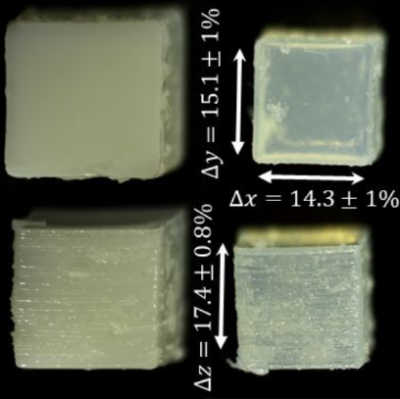For those getting started with 3D printers, thermoplastics such as ABS and PLA are the norm. For those looking to produce parts with some give, materials like Ninjaflex are most commonly chosen, using thermoplastic polyeurethane. Until recently, it hasn’t been possible to 3D print latex rubber. However, a team at Virginia Tech have managed the feat through the combination of advanced printer hardware and some serious chemistry.

The work was primarily a collaboration between [Phil Scott] and [Viswanath Meenakshisundaram]. After initial experiments to formulate a custom liquid latex failed, [Scott] looked to modify a commercially available product to suit the project. Liquid latexes are difficult to work with, with even slight alterations to the formula leading the solution to become unstable. Through the use of a molecular scaffold, it became possible to modify the liquid latex to become photocurable, and thus 3D printable using UV exposure techniques.
The printer side of things took plenty of work, too. After creating a high-resolution UV printer, [Meenakshisundaram] had to contend with the liquid latex resin scattering light, causing parts to be misshapen. To solve this, a camera was added to the system, which visualises the exposure process and self-corrects the exposure patterns to account for the scattering.
It’s an incredibly advanced project that has produced latex rubber parts with advanced geometries and impressive mechanical properties. We suspect this technology could be developed quickly in the coming years to produce custom rubber parts with significant strength. In the meantime, replicating flexible parts is still possible with available filaments on the market.
[via phys.org]















hope they publish more data on this, id like to know how the insertion of cleavage planes through printing will affect the properties of the material. i bet it shears from torque fairly easily, but deflection on x and y is better than traditionally molded latex
Indeed, also be interesting to see how they correct for the scatter effect and if that has any impact on the parts internal geometries.
Worst condom ever.
custom rubber parts
significant strength
It seems like you can pick one but not both.
Since it is more like resin/MSLA printing, why even compare it with FDM (PLA/ABS) printing in the first place?
I wonder how it compares to existing flexible SLA Resin like the ones made by Siraya Tech?
https://siraya.tech/
https://youtu.be/vjXQ8i1ronE
Why is this tagged with LaTeX, the formatting system?
Because WordPress ignores case when adding tags, so if LaTeX already exists as a tag and you add latex to a new article it gets association with the existing tag automatically.
“It’s an incredibly advanced project that has produced latex rubber parts with advanced geometries and impressive mechanical properties.”
Advanced geometries? This is not your father’s evolution.
Virginia tech is into latex printing … interesting.
( ͡° ͜ʖ ͡°)
That’s what i thought too. Who would paint with a 3D printer? Latex house paint would go so much faster with, I don’t know, a brush.
Yup.
Whatever you are thinking plus the l̶a̶y̶e̶r̶ ̶l̶i̶n̶e̶s bacteria pockets of 3d printed objects.
I’m sure your not the only one.
Shall we all start calling our local ERs and warning them they need to stock up on antibiotics now?
I wonder how well it adheres to other plastics. I like the idea of print-on bumpers using dual extrudes.